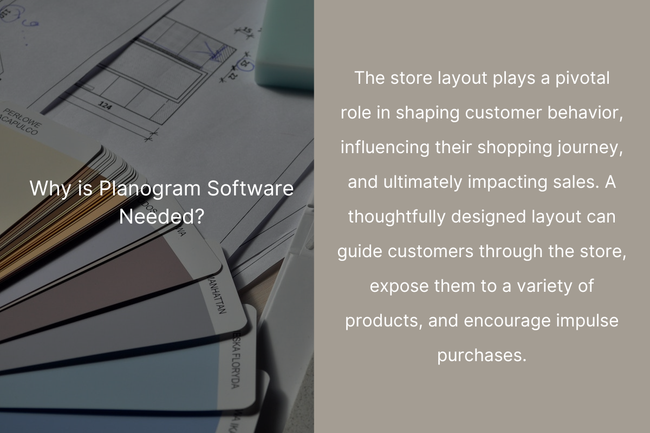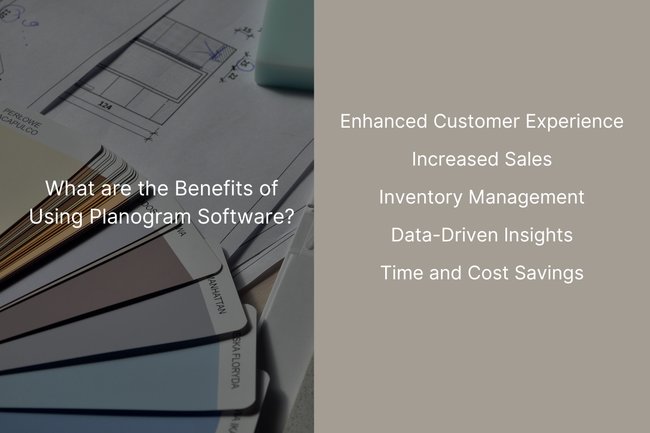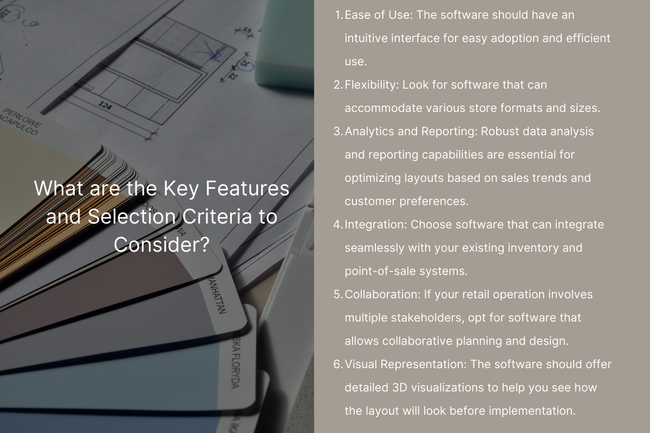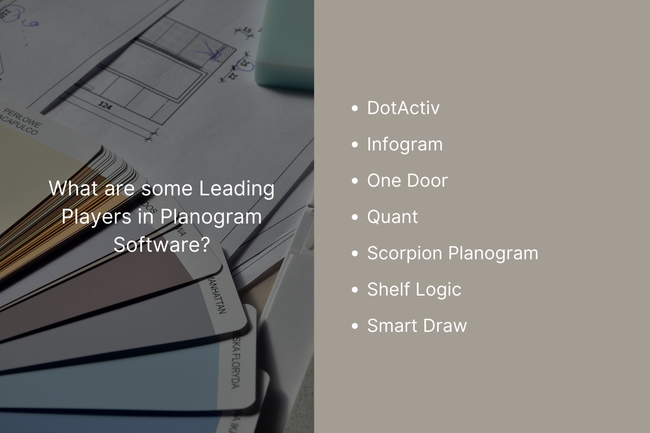In the dynamic world of retail, where competition is fierce and customer expectations are constantly evolving, staying ahead of the game is crucial. One powerful tool that can significantly impact a retailer's success is an effective store layout. A well-structured store layout not only enhances the shopping experience but also drives sales. To achieve this, retail businesses are increasingly turning to retail planogram software solutions.
The Importance of Store Layout
The store layout plays a pivotal role in shaping customer behavior, influencing their shopping journey, and ultimately impacting sales. A thoughtfully designed layout can guide customers through the store, expose them to a variety of products, and encourage impulse purchases. It also affects factors such as dwell time, customer satisfaction, and brand perception.

Understanding Retail Planogram Software
Retail planogram software is a technological solution that enables retailers to create, visualize, and manage store layouts and product placements. It's a strategic tool that leverages data and analytics to optimize product positioning, shelving arrangements, and overall store design.
Benefits of Using Planogram Software
Utilizing planogram software solutions offers a plethora of advantages that can significantly impact a retailer's success in today's competitive landscape. Firstly, it enables retailers to craft an enhanced customer experience by strategically positioning products and optimizing aisle layouts. By designing an intuitive and visually pleasing shopping journey, retailers can elevate customer satisfaction and foster brand loyalty.
Moreover, these software solutions contribute directly to revenue growth. Well-organized displays facilitated by planograms can actively encourage cross-selling and upselling opportunities, effectively boosting sales volumes and overall revenue. This targeted arrangement of products can subtly guide customers towards complementary items they may not have considered otherwise, thereby increasing the average transaction value.

Effective inventory management is another substantial benefit offered by planogram software. By ensuring products are accurately placed on shelves, retailers can minimize instances of out-of-stock situations, reducing missed sales opportunities. Simultaneously, the optimization of product placements contributes to minimizing excess inventory, leading to cost savings and improved inventory turnover rates.
One of the most impactful advantages is the data-driven insights that planogram software can provide. These tools yield valuable information on customer behavior, sales trends, and product performance. Retailers can leverage this data to make informed decisions about product assortment, shelving strategies, and marketing campaigns, ensuring their actions are aligned with actual customer preferences and market demands.
Time and cost savings are crucial elements of operational efficiency that planogram software brings to the table. The automation of store layout design processes streamlines workflows, saving significant time for retail teams. Additionally, human errors related to manual arrangement are minimized, leading to a reduction in costly inaccuracies. Furthermore, these tools optimize space utilization, ensuring that the available store space is used effectively, thereby reducing operational costs associated with inefficient layouts.
The benefits of using planogram software extend far beyond simple arrangement tactics. From enhancing customer experiences and driving sales to optimizing inventory management and providing data-driven insights, these software solutions empower retailers to make strategic decisions that positively impact their bottom line. The time and cost savings achieved through automation further underscore the value of incorporating planogram software into the retail business toolkit.
Key Features and Selection Criteria to Consider
Selecting the right planogram software is a pivotal decision that can greatly influence your retail business's success. To ensure you make an informed choice, it's essential to consider a range of key features and criteria.
Firstly, prioritize the ease of use. Opt for a software solution with an intuitive interface that empowers your team to quickly adopt and effectively utilize its functionalities. This is especially important for streamlining workflows and minimizing the learning curve.
Flexibility is paramount, as every retail store has its unique layout and requirements. Seek software that can adapt to various store formats and sizes, allowing you to tailor the planograms to your specific space and product assortment.
Robust analytics and reporting capabilities are crucial for informed decision-making. The software should offer sophisticated data analysis tools that help you decipher sales trends, customer preferences, and product performance. These insights are instrumental in optimizing layouts to align with market demands.
Integration with your existing systems is another vital consideration. A planogram software that seamlessly integrates with your inventory management and point-of-sale systems ensures accurate and real-time updates. This integration streamlines processes and maintains data consistency across your retail operation.

If your retail business involves collaboration among different teams or stakeholders, opt for a software solution that facilitates collaborative planning and design. This feature fosters effective communication and coordination, ensuring that all stakeholders are aligned and contribute to the optimization process.
The ability to visualize the planned layout in detail is indispensable. Look for software that provides intricate 3D visualizations. These visual representations give you a clear preview of how the layout will look once implemented, helping you identify potential issues or improvements before execution.
The key features and criteria outlined above should guide your decision-making process when selecting planogram software for your retail business. Prioritizing ease of use, flexibility, analytics, integration, collaboration, and visual representation will empower you to make a choice that enhances your store layouts and drives sales growth.
Top Retail Planogram Software Companies
Selecting the right retail planogram software solution can be a critical decision that profoundly impacts your store's layout optimization and overall retail strategy. With numerous options available in the market, each offering a unique set of features and advantages, it's essential to delve into a comprehensive comparison. In this section, we'll explore the key features, pros, and cons of some of the leading retail planogram software companies, including DotActiv, Infogram, One Door, Quant, Scorpion Planogram, Shelf Logic, and Smart Draw. By understanding the unique offerings of each platform, you can make an informed decision tailored to your retail business's specific needs and goals.
DotActiv
DotActiv offers a comprehensive suite of features designed to optimize store layouts and product placements. It provides category management, assortment planning, and data integration capabilities. The software supports both planogram automation and manual adjustments. It also offers advanced analytics for data-driven decision-making.
Pros:
- User-Friendly Interface: DotActiv offers an intuitive interface, making it accessible to users with varying levels of technical expertise.
- Customization: The software allows for extensive customization of planograms, catering to different store layouts and product assortments.
- Category Management: DotActiv emphasizes category management, helping retailers optimize their assortment and product placement strategies.
- Data Integration: It integrates well with various data sources, enabling data-driven decisions for planogram creation.
- Customer Support: DotActiv provides strong customer support, offering assistance in using the software effectively.
Cons:
- Learning Curve: While user-friendly, the software might still have a learning curve, especially for complex features.
- Cost: DotActiv's pricing might be on the higher side for smaller businesses with limited budgets.
- Advanced Analytics: While it offers analytics, some users might find the analytics features to be less advanced compared to specialized analytics platforms.
Infogram
Infogram is a data visualization tool that allows retailers to create interactive and engaging visual content, such as charts, graphs, and infographics. While it's not specifically a planogram software, it can be used to create visual representations of data that can aid in store layout decision-making.
Pros:
- Data Visualization: Infogram specializes in creating stunning data visualizations and infographics, making it useful for presenting planogram-related data.
- Ease of Use: The platform is designed for simplicity, enabling users to quickly create engaging visual content.
- Online Sharing: Infogram allows easy sharing of created infographics and visualizations online.
Cons:
- Limited Retail Focus: Infogram is not specifically designed for retail planogramming, so it might lack some advanced features tailored to this industry.
- Limited Analytics: While it excels in visualization, it may lack robust data analytics features required for detailed retail optimization.
- Integration: Infogram might not integrate as seamlessly with retail data sources as specialized planogram software.
One Door
One Door's Merchandising Cloud offers visual merchandising and store execution capabilities. It provides tools for designing store layouts, optimizing product placement, and managing execution through mobile apps.
Pros:
- Visual Merchandising: One Door focuses on visual merchandising, helping retailers enhance their store layouts and product displays.
- Real-time Collaboration: The software offers collaborative features, aiding teams in working together on planogram design.
- Mobile Access: One Door provides mobile capabilities, enabling users to work on planograms remotely.
Cons:
- Limited Customization: The software might be less customizable compared to some other planogram solutions.
- Cost: One Door's pricing structure might be prohibitive for smaller retailers.
- Learning Curve: Users might require some time to get accustomed to the platform's functionalities.
Quant
Quant offers cloud-based planogram software with advanced analytics, allowing retailers to create optimized store layouts. It supports assortment planning, store clustering, and real-time performance tracking.
Pros:
- Automated Optimization: Quant specializes in automated planogram optimization, leveraging algorithms to create efficient layouts.
- Integration: It integrates with various data sources for real-time updates and accuracy.
- Category Insights: The software focuses on category management and offers insights to enhance assortment strategies.
Cons:
- Complexity: The advanced optimization features might be complex for users without a strong technical background.
- Learning Curve: The platform's algorithms might require understanding and training to use effectively.
- Limited Customization: While it excels in optimization, it might have limitations in terms of layout customization.
Scorpion Planogram
Scorpion Planogram leverages AI for intelligent product placement recommendations. It focuses on enhancing customer engagement and driving sales through data-driven insights.
Pros:
- AI-Powered Recommendations: Scorpion Planogram stands out with AI-driven product placement recommendations for optimized layouts.
- User-Friendly: The software boasts a user-friendly interface and easy-to-use tools for creating planograms.
- Real-time Updates: Real-time data integration allows for up-to-date planograms based on changing trends.
Cons:
- Relatively New: As a newer entrant, the software might still be evolving and refining its features.
- Advanced Analytics: While it offers AI recommendations, the software might lack some advanced analytics compared to established players.
- Customization: Users seeking highly customizable layouts might find limitations with AI-driven recommendations.
Shelf Logic
Shelf Logic offers planogram software for creating detailed store layouts with a focus on shelf and product placement optimization.
Pros:
- Flexibility: Shelf Logic is known for its flexibility, accommodating various store formats and sizes.
- Visual Realism: The software provides realistic 3D visualizations, aiding in accurate layout assessment.
- Integration: It integrates with other retail systems for seamless data flow.
Cons:
- Complexity: The advanced features might require training and technical understanding for optimal use.
- Learning Curve: Some users might find the learning curve steep, particularly when using advanced 3D visualization tools.
- Cost: Shelf Logic's pricing might be higher, especially for smaller retailers.
Smart Draw
SmartDraw offers planogram software that enables retailers to create store layouts, visualize product placements, and optimize displays.
Pros:
- Ease of Use: Smart Draw emphasizes its simplicity, making it accessible for users without extensive design experience.
- Quick Visualization: The software allows for rapid creation of visualizations, aiding in quick planogram design.
Cons:
- Limited Retail Focus: Smart Draw is not specifically tailored for retail planogramming, so it might lack specialized retail features.
- Customization: While user-friendly, it might have limitations in terms of layout customization and advanced features.
- Advanced Analytics: The software might not offer as comprehensive analytics as specialized retail planogram solutions.
Remember that the choice of retail planogram software should align with your specific business needs, budget, and technical capabilities. It's essential to evaluate each option carefully and choose the one that best suits your retail operation's requirements.
The Future of Retail Planogram Software
As technology continues to advance, the future of retail planogram software holds exciting possibilities. Expect to see more integration with artificial intelligence and machine learning, enabling even more precise product placements based on real-time data. Virtual and augmented reality might also play a role in creating immersive virtual store simulations for layout testing.

Conclusion
In the ever-evolving retail landscape, optimizing store layouts is more critical than ever. Retail planogram software solutions offer a way to harness the power of data and technology to create layouts that enhance customer experiences, drive sales, and streamline operations. As the industry continues to evolve, selecting the right planogram software tailored to your business needs will undoubtedly be a strategic decision that pays dividends in the long run.

